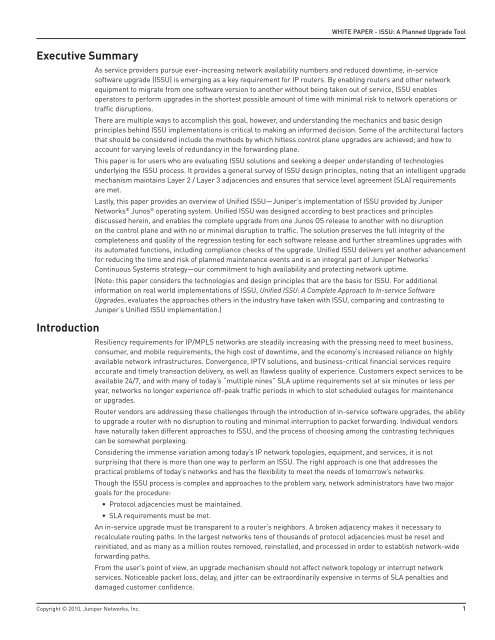ISSU: A Planned Upgrade Tool - Juniper Networks
ISSU: A Planned Upgrade Tool - Juniper Networks
ISSU: A Planned Upgrade Tool - Juniper Networks
You also want an ePaper? Increase the reach of your titles
YUMPU automatically turns print PDFs into web optimized ePapers that Google loves.
Executive Summary<br />
Introduction<br />
WHITE PAPER - <strong>ISSU</strong>: A <strong>Planned</strong> <strong>Upgrade</strong> <strong>Tool</strong><br />
As service providers pursue ever-increasing network availability numbers and reduced downtime, in-service<br />
software upgrade (<strong>ISSU</strong>) is emerging as a key requirement for IP routers. By enabling routers and other network<br />
equipment to migrate from one software version to another without being taken out of service, <strong>ISSU</strong> enables<br />
operators to perform upgrades in the shortest possible amount of time with minimal risk to network operations or<br />
traffic disruptions.<br />
There are multiple ways to accomplish this goal, however, and understanding the mechanics and basic design<br />
principles behind <strong>ISSU</strong> implementations is critical to making an informed decision. Some of the architectural factors<br />
that should be considered include the methods by which hitless control plane upgrades are achieved; and how to<br />
account for varying levels of redundancy in the forwarding plane.<br />
This paper is for users who are evaluating <strong>ISSU</strong> solutions and seeking a deeper understanding of technologies<br />
underlying the <strong>ISSU</strong> process. It provides a general survey of <strong>ISSU</strong> design principles, noting that an intelligent upgrade<br />
mechanism maintains Layer 2 / Layer 3 adjacencies and ensures that service level agreement (SLA) requirements<br />
are met.<br />
Lastly, this paper provides an overview of Unified <strong>ISSU</strong>—<strong>Juniper</strong>’s implementation of <strong>ISSU</strong> provided by <strong>Juniper</strong><br />
<strong>Networks</strong> ® Junos ® operating system. Unified <strong>ISSU</strong> was designed according to best practices and principles<br />
discussed herein, and enables the complete upgrade from one Junos OS release to another with no disruption<br />
on the control plane and with no or minimal disruption to traffic. The solution preserves the full integrity of the<br />
completeness and quality of the regression testing for each software release and further streamlines upgrades with<br />
its automated functions, including compliance checks of the upgrade. Unified <strong>ISSU</strong> delivers yet another advancement<br />
for reducing the time and risk of planned maintenance events and is an integral part of <strong>Juniper</strong> <strong>Networks</strong>’<br />
Continuous Systems strategy—our commitment to high availability and protecting network uptime.<br />
(Note: this paper considers the technologies and design principles that are the basis for <strong>ISSU</strong>. For additional<br />
information on real world implementations of <strong>ISSU</strong>, Unified <strong>ISSU</strong>: A Complete Approach to In-service Software<br />
<strong>Upgrade</strong>s, evaluates the approaches others in the industry have taken with <strong>ISSU</strong>, comparing and contrasting to<br />
<strong>Juniper</strong>’s Unified <strong>ISSU</strong> implementation.)<br />
Resiliency requirements for IP/MPLS networks are steadily increasing with the pressing need to meet business,<br />
consumer, and mobile requirements, the high cost of downtime, and the economy’s increased reliance on highly<br />
available network infrastructures. Convergence, IPTV solutions, and business-critical financial services require<br />
accurate and timely transaction delivery, as well as flawless quality of experience. Customers expect services to be<br />
available 24/7, and with many of today’s “multiple nines” SLA uptime requirements set at six minutes or less per<br />
year, networks no longer experience off-peak traffic periods in which to slot scheduled outages for maintenance<br />
or upgrades.<br />
Router vendors are addressing these challenges through the introduction of in-service software upgrades, the ability<br />
to upgrade a router with no disruption to routing and minimal interruption to packet forwarding. Individual vendors<br />
have naturally taken different approaches to <strong>ISSU</strong>, and the process of choosing among the contrasting techniques<br />
can be somewhat perplexing.<br />
Considering the immense variation among today’s IP network topologies, equipment, and services, it is not<br />
surprising that there is more than one way to perform an <strong>ISSU</strong>. The right approach is one that addresses the<br />
practical problems of today’s networks and has the flexibility to meet the needs of tomorrow’s networks.<br />
Though the <strong>ISSU</strong> process is complex and approaches to the problem vary, network administrators have two major<br />
goals for the procedure:<br />
• Protocol adjacencies must be maintained.<br />
• SLA requirements must be met.<br />
An in-service upgrade must be transparent to a router’s neighbors. A broken adjacency makes it necessary to<br />
recalculate routing paths. In the largest networks tens of thousands of protocol adjacencies must be reset and<br />
reinitiated, and as many as a million routes removed, reinstalled, and processed in order to establish network-wide<br />
forwarding paths.<br />
From the user’s point of view, an upgrade mechanism should not affect network topology or interrupt network<br />
services. Noticeable packet loss, delay, and jitter can be extraordinarily expensive in terms of SLA penalties and<br />
damaged customer confidence.<br />
Copyright © 2010, <strong>Juniper</strong> <strong>Networks</strong>, Inc. 1
















